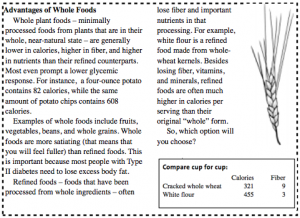Managing Diabetes
 • Lose weight if you are overweight. Type II diabetes that arises with obesity is also likely to go away... if the obesity does too. Even limited weight loss can lead to better blood glucose control.• Participate in regular physical activity. Regular physical activity improves fitness and quality of life. It also decreases your risk of cardiovascular disease and helps with weight loss or control. With Type II diabetes, regular physical activity helps to improve blood glucose control and possibly decrease the need for insulin or oral medications.• Watch the amount of saturated fat, trans-fat, and cholesterol you consume, as they tend to raise blood cholesterol levels. Foods to avoid include fatty meats, fried foods, high-fat dairy products, bakery goods, and most margarines. Try beans as your main source of protein for a while, and mix things up with some fish or lean poultry.• Increase your intake of fiber. Fiber comes from plants and may help lower blood glucose and fat levels in the blood. Foods that are high in fiber include bran cereals, cooked beans and peas, whole-grain bread, fruits, and vegetables.• Eat more whole grains, fruits, and vegetables. Eat these healthy options instead of refined foods. Not only do whole foods contain fiber, but they also contain numerous plant chemicals, which appear to be very good for your health.• Eat regular, well-balanced meals and small snacks. This will help to improve your blood glucose levels and reduce the likelihood that you will overeat.• Understand that “sugar-free” doesn’t mean calorie-free. “Sugar-free” foods are often sweetened with fructose or sugar alcohols (xylitol, mannitol, sorbitol). These sweeteners may have a smaller effect on your blood glucose levels than table sugar, and they are okay to use in moderate amounts. But foods containing fructose or sugar alcohols will still contain calories. Even foods sweetened with artificial sweeteners (such as sugar-free pudding) still have calories and are not “free” foods.• Know the carbohydrate content of the foods you eat. Carbohydrates occur naturally in milk and fruit, and are also found in pasta, bread, rice, dried beans and peas, and starchy vegetables like potatoes, corn, or green peas.• Use alcohol in moderation. If your blood glucose levels are in control and you consume the alcohol with foods that contain carbohydrates, one drink a day is acceptable. However, it is important to monitor your blood glucose to know how you will react to alcohol, especially since alcohol can lead to hypoglycemia.• Know where to go for reliable information. The following organizations offer credible information for consumers with diabetes:
• Lose weight if you are overweight. Type II diabetes that arises with obesity is also likely to go away... if the obesity does too. Even limited weight loss can lead to better blood glucose control.• Participate in regular physical activity. Regular physical activity improves fitness and quality of life. It also decreases your risk of cardiovascular disease and helps with weight loss or control. With Type II diabetes, regular physical activity helps to improve blood glucose control and possibly decrease the need for insulin or oral medications.• Watch the amount of saturated fat, trans-fat, and cholesterol you consume, as they tend to raise blood cholesterol levels. Foods to avoid include fatty meats, fried foods, high-fat dairy products, bakery goods, and most margarines. Try beans as your main source of protein for a while, and mix things up with some fish or lean poultry.• Increase your intake of fiber. Fiber comes from plants and may help lower blood glucose and fat levels in the blood. Foods that are high in fiber include bran cereals, cooked beans and peas, whole-grain bread, fruits, and vegetables.• Eat more whole grains, fruits, and vegetables. Eat these healthy options instead of refined foods. Not only do whole foods contain fiber, but they also contain numerous plant chemicals, which appear to be very good for your health.• Eat regular, well-balanced meals and small snacks. This will help to improve your blood glucose levels and reduce the likelihood that you will overeat.• Understand that “sugar-free” doesn’t mean calorie-free. “Sugar-free” foods are often sweetened with fructose or sugar alcohols (xylitol, mannitol, sorbitol). These sweeteners may have a smaller effect on your blood glucose levels than table sugar, and they are okay to use in moderate amounts. But foods containing fructose or sugar alcohols will still contain calories. Even foods sweetened with artificial sweeteners (such as sugar-free pudding) still have calories and are not “free” foods.• Know the carbohydrate content of the foods you eat. Carbohydrates occur naturally in milk and fruit, and are also found in pasta, bread, rice, dried beans and peas, and starchy vegetables like potatoes, corn, or green peas.• Use alcohol in moderation. If your blood glucose levels are in control and you consume the alcohol with foods that contain carbohydrates, one drink a day is acceptable. However, it is important to monitor your blood glucose to know how you will react to alcohol, especially since alcohol can lead to hypoglycemia.• Know where to go for reliable information. The following organizations offer credible information for consumers with diabetes:
- American Dietetic Association: www.eatright.org
- American Diabetes Association: www.diabetes.org
- National Institute of Diabetes & Digestive & Kidney Diseases: www.niddk.nih.gov
By Beth Fontenot, MS, RD.
